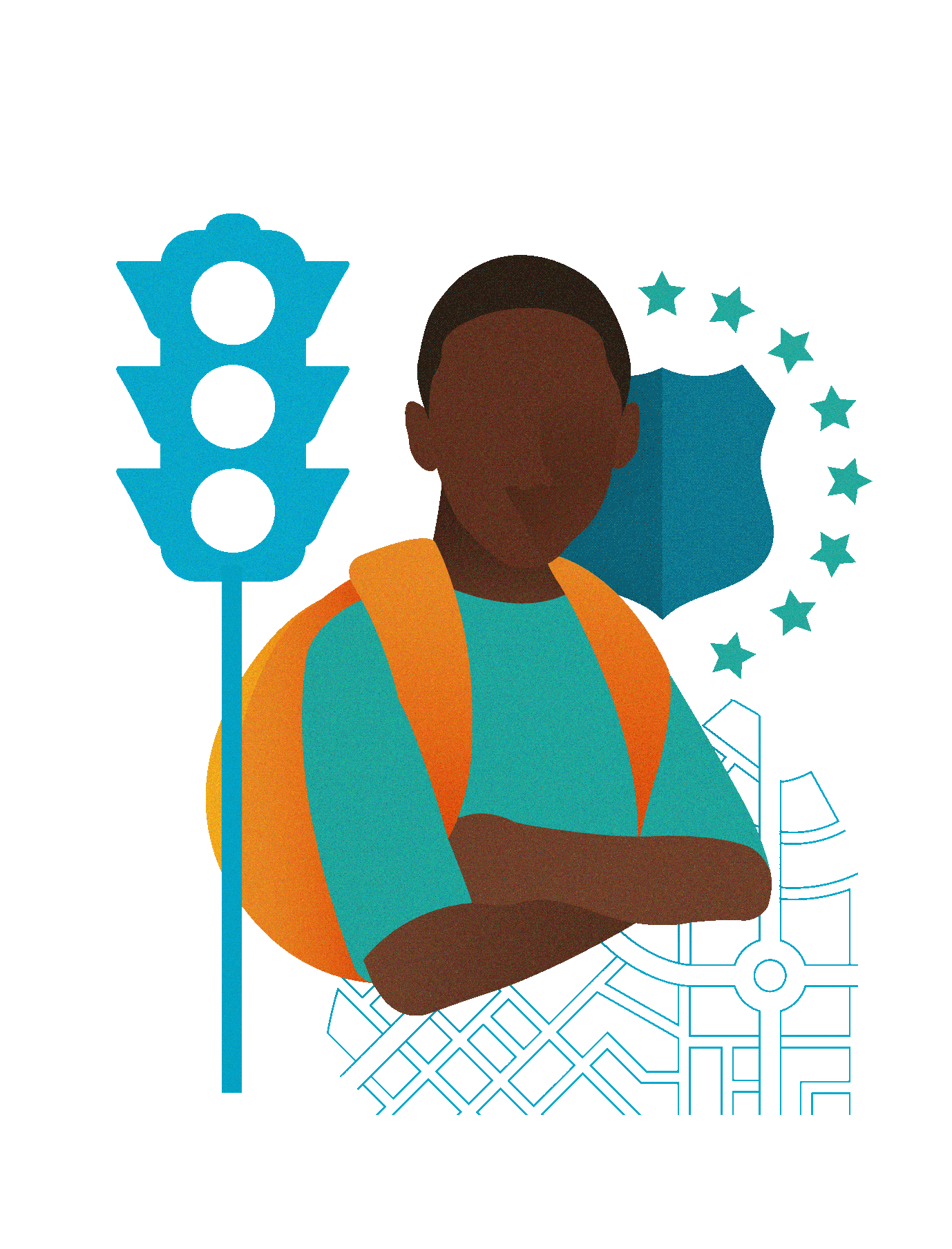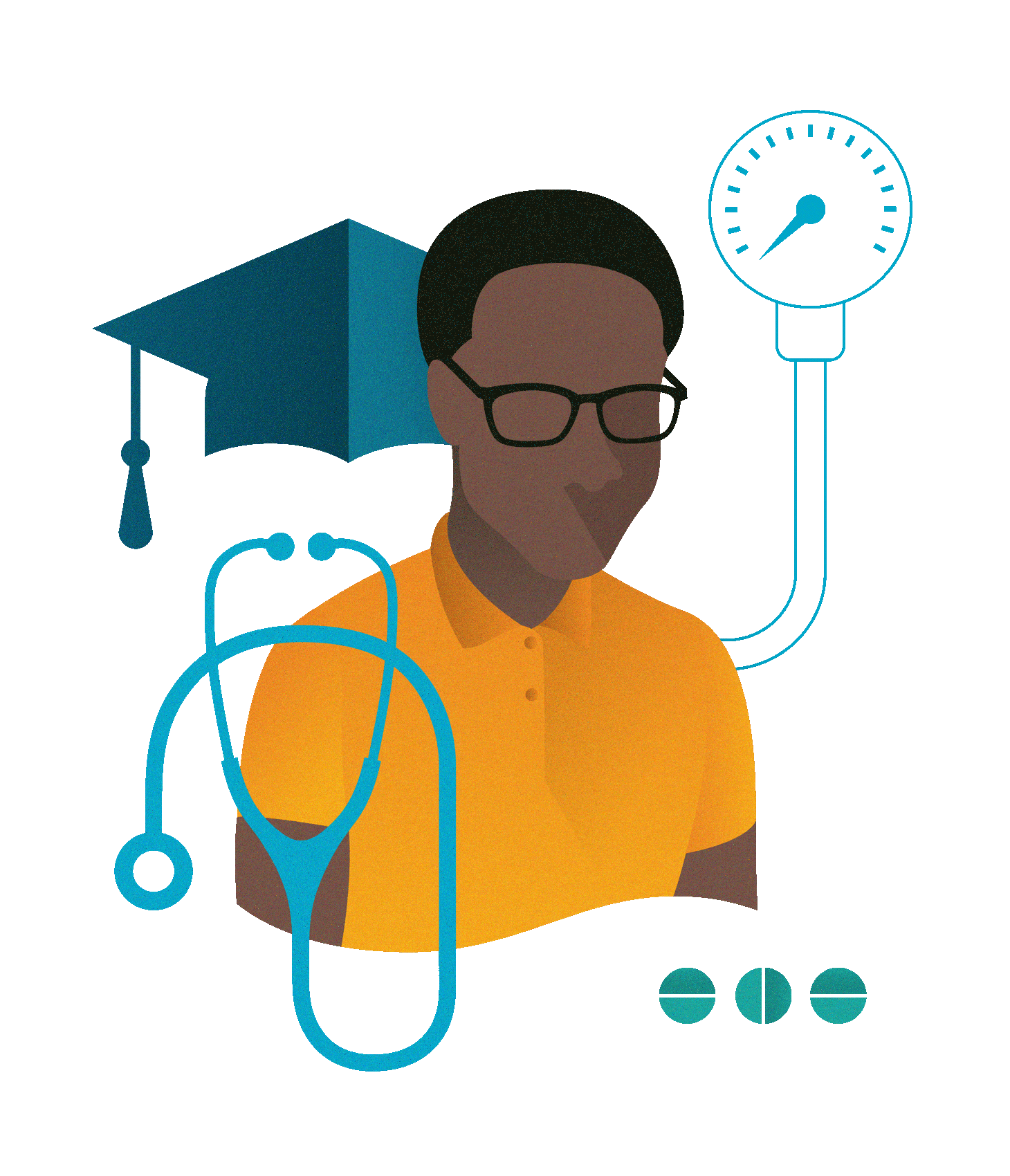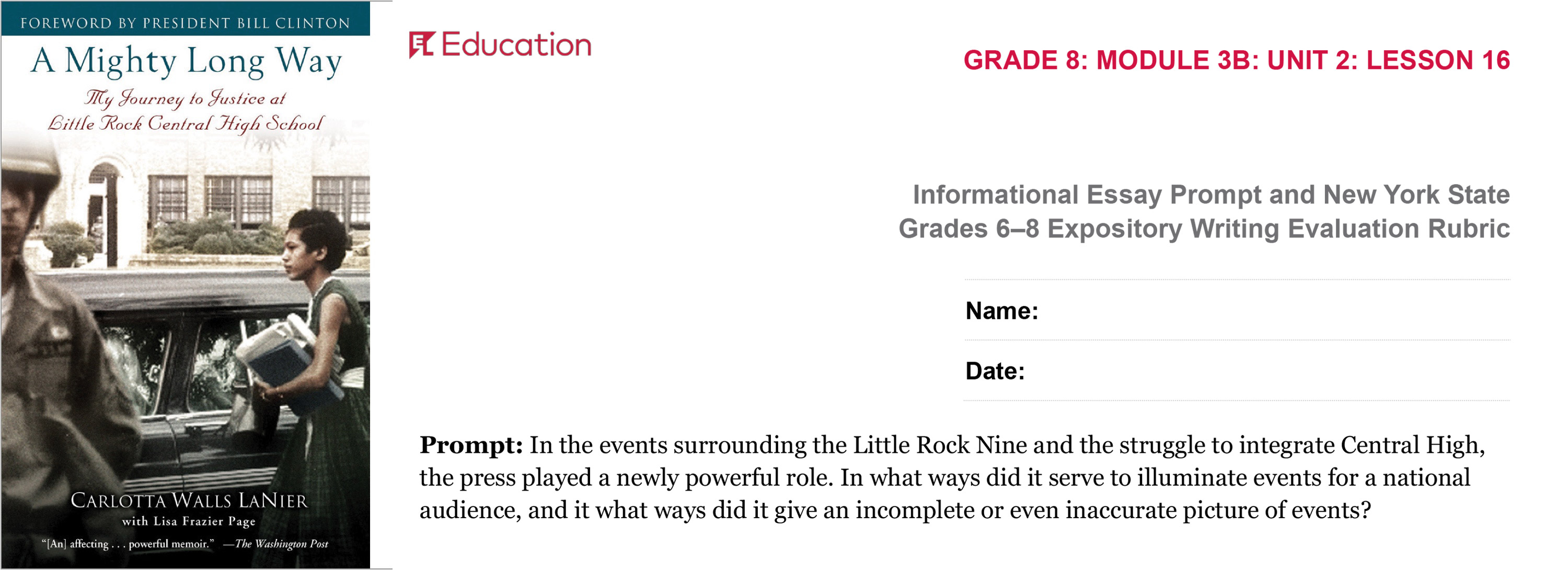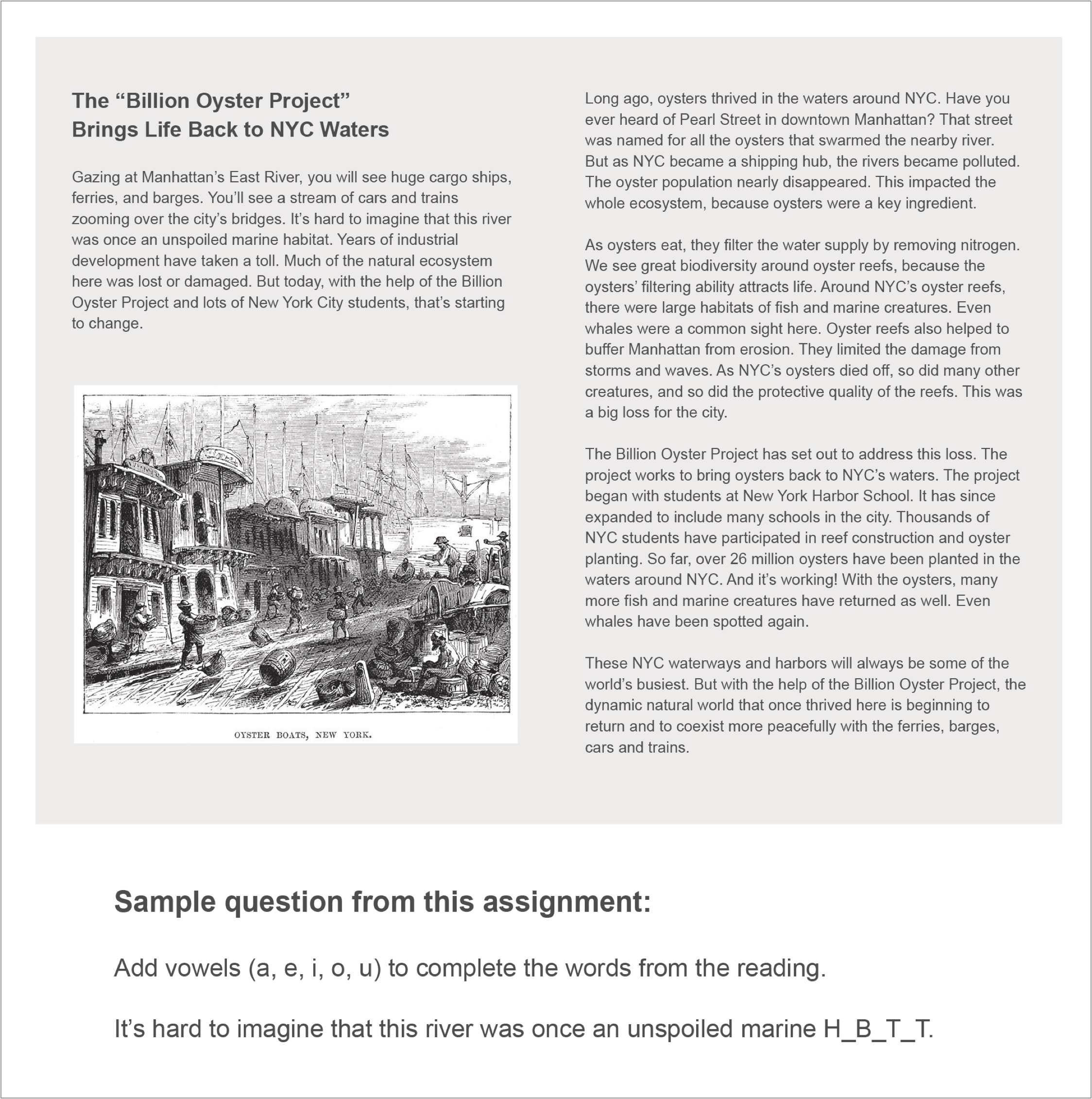The Weight of Wasted Time

GRADE-APPROPRIATE ASSIGNMENTS
Hajima and her classmates will never get their time back—and it adds up. In the four core subjects—ELA, math, science, and social studies—an average student spent almost three-quarters of their time on assignments that were not grade-appropriate (Figure 5).18 In a single school year, that’s the equivalent of more than six months of learning time.19
Consider the experience of the eighth graders in an ELA classroom who were asked to fill in missing vowels in a vocabulary worksheet. Or the students in an AP physics classroom, who spent an entire class period making a vocabulary poster. These sound like extreme examples, but they were far more the norm than the exception.
When students are consistently forced to do work below their grade level, they’re missing opportunities to learn and practice the skills they’ll need to make their life goals achievable. But they’re also being denied a chance to prove—to themselves as much as anyone else—what they are capable of. Consider the student in one of our partner districts who was asked to solve a variety of word problems using addition and subtraction (a first-grade standard) and multiplication and division (a third-grade standard). That might be all right, except for one problem: This student was in fourth grade.
Of the 180 classroom hours in each core subject during the school year, students spent...
133 Hours
on assignments that were not grade appropriate
47 Hours
on assignments that were grade appropriate
He did the work he was assigned, and answered 87 percent of the questions correctly. But the assignment offered him only the opportunity to grapple with content that was more appropriate for younger students.
Another assignment in the same classroom offered a better opportunity: The same student was asked to identify equivalent fractions using visual models, meeting a fourth-grade standard. Here, on the more challenging assignment, he answered 100 percent of the questions correctly.
The fourth-grade student who performed better on the grade-appropriate assignment compared to the easier one does not necessarily indicate that students are more likely to do better on tougher content; overall, students are still more likely to meet the demands of less challenging assignments versus more challenging ones. But his experience debunks the common assumption that students can’t do more rigorous work. This student was ready, willing, and able to complete whatever assignment he was offered. Even more importantly, his example upends the belief that achievement mainly reflects students’ abilities. The key variable is actually adults’ decisions.
Neither this student nor his teacher would have known he could do well on the tougher assignment if he hadn’t been given the chance—a chance he and every other student must rely on the adults in their schools to give them. In our observations, we saw hundreds of students demonstrating their ability to do grade-level work when asked to do so, including students with low prior achievement. But most—especially students of color and those from low-income families—don’t get those opportunities nearly often enough.
The Role of Curriculum and Assessment Policies
The content in front of students on a daily basis isn’t good enough—simple as that. While improving content isn’t a quick fix, giving students better assignments that are appropriately challenging will give more students the chance to get on track to meet their goals. Given the variation from classroom to classroom and the disheartening level of materials overall, a key question is: Where do these assignments originate? Who defines what students are asked to do and when?
We looked at state- and district-level policies on curriculum adoption, as well as the quality of the materials districts chose. On the whole, we found that our partner districts were adopting materials of widely varying quality—and that in spite of having these district-provided materials, teachers were spending a significant amount of their planning time creating or selecting their own. The typical teacher in our sample reported spending seven hours per week on this, which adds up to more than 250 hours a year—hugely valuable time for teachers who are already stretched thin.
This might be time well-spent if there were evidence that teacher-created materials were giving students access to stronger content than those provided by districts. But this wasn’t the case. In fact, materials created or selected by teachers were generally less likely than those provided by the district to meet academic standards in ELA and math. On average, teacher-created or selected materials aligned to academic standards, meaning they earned our highest content rating, 20 percent of the time, while district-adopted materials aligned 34 percent of the time.
This alignment was even higher when districts had adopted high-quality materials: When teachers reported that their assignments came from high-quality district offerings, the assignments were grade-appropriate 53 percent of the time. Districts’ choices, in other words, were far from universally great—but they were a stronger start than materials teachers found or created from scratch.
We also looked at district-mandated interim assessments to understand what kind of feedback they were providing teachers about their students’ performance against grade-level state standards. All of our districts required their teachers to administer at least quarterly interim assessments in both math and ELA—but none of these assessments met the bar for full alignment to the standards: Of a sampling of 38 interim assessments in math and ELA, just two were “partially aligned” to appropriate benchmarks. The remaining 36 were “not aligned,” largely because they did not ask students grade-appropriate questions. We heard overwhelmingly from teachers that they used these assessments to drive adjustments to their instruction—as they should, as that is a fundamental goal of measuring student progress. But in our partner districts, teachers were receiving misinformation from the mandated assessments, undermining teachers’ efforts to adjust their instruction in ways that would improve student outcomes (and quite possibly confusing teachers about what grade-appropriate content looks like).20
About 5

STRONG INSTRUCTION
In assessing the quality of instruction, we looked at classrooms’ cultures and whether students were doing the work of the lesson. We also considered whether students had a chance to work on grade-level content during the lesson, and whether teachers’ instructional practices allowed students to do the thinking about that grade-level content.
Only 16 percent of the lessons we observed in core subjects offered strong instruction: instructional practices that allowed students to grapple with appropriate material in robust ways. Out of 180 hours per school year in each core subject, that means students spent just 29 hours with strong instruction (Figure 6).
The problem is not just that the content in front of students isn’t strong enough—although as we’ve already seen, that is often the case. It’s also that when content is high-quality and grade-appropriate, many students still don’t have the opportunity to actually do the work themselves. Too often, we saw teachers making choices that protected—or prevented—students from doing the thinking of the lesson. Even if those instructional choices were motivated by a desire to see students succeed, they undermined the benefits of high-quality content in the first place. If these lessons represented students’ typical experiences, they were spending the equivalent of fewer than two months experiencing strong instruction, and more than seven months doing something else.
Even when we did see students offered grade-appropriate assignments, their teachers engaged them effectively with that content less than half the time, and students had the chance to do the deep thinking of the lesson just a quarter of the time. That means in the 295 lessons that offered grade-level content—already just a fraction of the nearly 900 core subject lessons we observed in total—only 74 lessons also focused on developing understanding and required students to do the thinking.21 In other words, in many classrooms where the content had potential, students weren’t actually reaping the benefits because they were not doing the hard work themselves.
Of the 180 classroom hours in each core subject during the school year, students spent...
151 Hours
on lessons with weak instruction
29 Hours
on lessons with strong instruction
When students “do the thinking” in a lesson, they grapple with the process of solving problems. They might be applying prior knowledge to answer new kinds of questions, or working in small groups to discuss different ways to solve a grade-level math problem. They might be writing an argument after reading and evaluating multiple texts that shared different perspectives about an issue. In classrooms where students don’t have these kinds of opportunities, they are often doing more listening than talking. They are writing their teachers’ answers verbatim, plugging numbers into a formula they’ve been supplied, or filling in blanks.
In many classrooms where the content had potential, students weren’t actually reaping the benefits because they were not doing the hard work themselves.
Ownership in the classroom matters.22 It’s not only how the brain learns best—by trying out new skills and wrestling with new knowledge and experiences ourselves, rather than just receiving information—but it’s also how students build the confidence to take on new challenges. When students are asked to try in school, when they are asked to push their thinking even when they’re stuck, to explain why they’ve arrived at an answer, to help a classmate, they also have the chance to stretch their sense of their own capabilities and see themselves grow.
Strong instruction that asks students to grapple with challenging content—and that cultivates a classroom-wide expectation that it’s okay to be wrong—has the potential to increase students’ natural drive to learn, rather than squander it. That can in turn deepen students’ engagement in school.

DEEP ENGAGEMENT
We know that the majority of students were “on task” in the classrooms we observed. Being on task and doing what’s asked in class certainly matter; it should be a baseline expectation that students are working on activities related to their lessons during class time. This is necessary, but it is not sufficient, because “engagement” at first glance—behavioral compliance—doesn’t mean students are truly engaged, cognitively and emotionally, with the work they’re doing.
When we measured “engagement,” we wanted to look at whether students were making a deeper cognitive and emotional investment in their schoolwork. We considered whether students were (1) enjoying what they were doing; (2) interested in it; and (3) concentrating deeply on it.23 When we looked at “worth,” we considered whether students found the content (1) usable outside of school; (2) important now; or (3) important in the future.24 Though most students we observed were completing their work (and even doing well on those assignments), middle and high school students found their school experiences engaging and worthwhile less than half the time (Figure 7).
Deep engagement is not a nice-to-have in school. Isaac’s reflections on what it feels like to sit in a “dry” lesson, where he’s not learning anything that will stick with him or help him later in life, should not be dismissed as a teenager’s complaints. His observations are supported by neuroscience: Deep learning only happens when people are cognitively and emotionally engaged with the material in front of them (and when people feel safe in their environment).25 Students do better academically when they feel engaged like this. In our sample, students were likely to earn better grades and find greater success in classrooms where they also reported feeling engaged.
But most students don’t have that opportunity regularly. More than 2,000 students told us about their experiences in school on at least five separate occasions. Among them, nearly half rarely or never had an experience that they believed was both engaging and worthwhile.26
And the further students get into their school careers, the less engaged they’re likely to be. Elementary students were more engaged and considered their schoolwork more worthwhile than their older peers. By the time they reached high school—just as their identities and career aspirations started to solidify and students began to recognize the content and skills they would need to meet their goals—more and more students perceived their schoolwork to be disconnected from their futures. High school students reported that 58 percent of their experiences were not engaging and 60 percent were not worthwhile: They were disconnected from their realities and irrelevant for their futures. Perhaps it’s not a surprise, then, that nearly half a million students drop out of high school every year.27
Middle and high school students found their lessons engaging or worthwhile less than half the time.
When we surveyed students in real time in their classrooms, we found them thinking about a variety of things beyond the lesson. When asked “What are you thinking about right now?” students in low-engagement classrooms reported musings on everything from “lunch” to “sleep” to “Beyoncé.” This range of responses was true even when students were, in practice, on task in class. They were doing the work in front of them, but their assignments did not require their full focus.
This was in contrast to classrooms that scored higher on our measure of engagement. In these classrooms, students reported thinking about things like “our group work” or “what I was working on.” Clearly, students were prepared to focus on the work at hand, but it needed to be intellectually stimulating and worthy of their attention to engage them.
On the whole, we found that the notion that many teenagers “hate school” simply wasn’t the case. They were far from uniformly negative about school, nor were they consistently disengaged across all their classes, every day of the week. In fact, students were attuned to improvements in instruction, in particular. When we looked at individual students’ experiences of the same classroom, we found that students who were disengaged on a day with weak instruction tended to report higher levels of engagement on a day when we observed stronger instruction.28
Disengagement, day after day, has an impact on how students feel about not only school, but also themselves. We asked students to respond to a variety of survey prompts to get a sense of how often they feel things like “proud” and “successful” in school. While we can’t know for certain how students define these feelings, the results were telling: 63 percent of the time, high school students reported that they did not feel a sense of pride during the school day. Students in classrooms with weaker instruction were less likely to report feeling proud than their peers in classrooms with stronger instruction.
Perhaps most important of all for students’ engagement, as Isaac inferred, are the relationships between teachers and students. When students believed their teachers expected them to learn a lot, they were twice as likely to find class engaging. Classrooms where teachers reported frequently talking with their students about their interests and goals—getting to know their students, beyond the assignments they do in class—had 34 percent higher rates of engagement.29
That’s what Mr. Adams does for Isaac. Luz, his schoolmate, agrees that this matters.

HIGH EXPECTATIONS
The vast majority of students (93 percent of those we surveyed) agreed that it’s important to their teachers that they learn a lot. And students like Luz correctly intuit that what their teachers expect of them in class has an impact on what they learn: When teachers have high expectations for students’ success against grade-level standards, it informs their choices about the content they put in front of students, and the instructional practices they employ.
That sounds like common sense, and it plays out in the data. In classrooms where teachers had higher expectations, we also saw stronger assignments, instruction, and ultimately greater student growth, compared to classrooms where teachers reported the lowest expectations for their students.
But those low expectations for student success were rampant. While 82 percent of teachers were supportive of state-level standards in theory, just 44 percent of teachers believed their own students could meet such high demands (Figure 8). When that translates into choices about content and instruction—and into the messages those choices send to students—it makes a meaningful impact on students’ school experiences and outcomes.
When teachers have low expectations, it may also contribute to a mismatch between the grades students bring home and their actual mastery of grade-level work and skills, because those grades often fail to reflect their success on work that is appropriately challenging. While nearly two-thirds of students across our partner districts earned As and Bs over the last few years, far fewer met the grade-level bar set by their state’s standardized assessments. In one partner district, less than 20 percent of B students did so.30
While higher grades did correspond to a greater chance that students could do grade-level work on these assessments, that chance was not especially great, even for students who were bringing home As and Bs. On the whole, students who were earning Bs on their math and ELA coursework had a less than 35 percent chance of having met their state assessment’s grade-level bar. Even an A was far from a guarantee: 29 percent of A students did not meet their state assessment’s grade-level bar. And we found the same disconnect when we compared students’ grades to college entrance exams and AP tests: Roughly half of students who typically received a B in math and ELA met the ACT’s or SAT’s college readiness benchmarks, and only 20 percent of students who earned a B in their AP math or English course actually passed the AP exam.
This is not purely about teachers’ individual expectations and the choices that flow from them. The reality is that teachers are themselves acting within a system that shapes and confines the choices they make for students. Although we know that some teachers do make decisions that buck systemic trends, and that teachers have the power to be vigilant about what goes on in their own classrooms, their choices are also heavily influenced by the training, development, and support they’re offered. For example, when the importance of high expectations (and the influence of teachers’ unconscious biases on those expectations) is not prioritized in teacher preparation programs, it’s unreasonable to expect most teachers to prioritize it on their own. The system sends teachers the message that the material they teach and the practices they employ in their classrooms matter far more than the expectations they hold for their students. Yet in our partner districts, these expectations had a stronger relationship to student achievement growth than any other factor we studied.
Moreover, in a system where many students pass from year to year under-prepared for what comes next, teachers often find themselves teaching students who truly aren’t yet working at grade level. They feel forced to choose between assigning grade-level work that’s beyond their students’ current skillset, or assigning work that matches those skills—but is below grade level.
The system sends teachers the message that the material they teach and the practices they employ in their classrooms matter far more than the expectations they hold for their students. Yet in our partner districts, these expectations had a stronger effect on student achievement growth than any other factor we studied.
In principle, the solution to this is “scaffolding”: Teachers should provide students the support they need to access grade-level work, regardless of their starting point, and do so as quickly as possible during the school year. But in practice, scaffolding—not to mention differentiating that support in a classroom with students who start at many different levels—is a complex skill to master. Many teachers simply don’t have the training and support in place to do it effectively. Even with the right skills and best intentions, meeting 25 or 30 individual students where they are isn’t possible without additional adults in the room, the right kinds of resources and technology, and a host of other resources that most teachers don’t have.
The result is the continuation of a cycle in which students who are behind grade level—who are all too often students of color, those from low-income backgrounds, students with mild to moderate disabilities, or English language learners—are continuously exposed to work that never gives them the chance to catch up.



